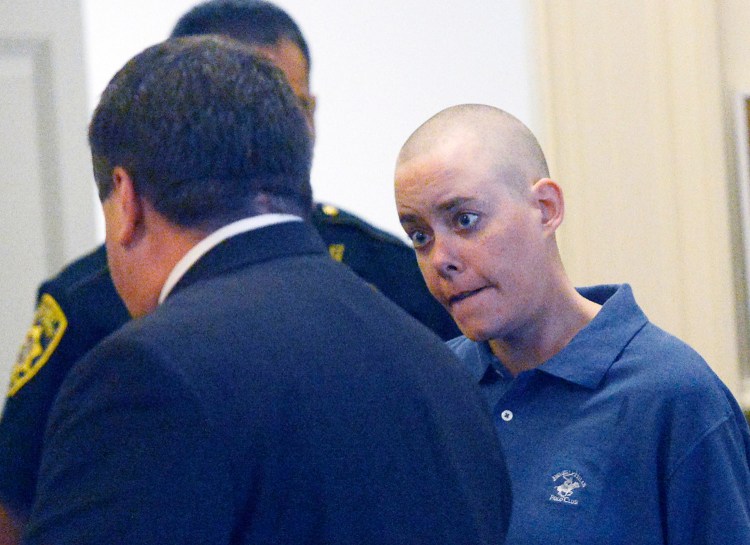When Connor MacCalister arrived at the York County Jail last week, charged with murdering a woman in a Saco supermarket, jail officials faced a decision about where to house him.
MacCalister, 31, was born Tanisha Hopkins, a woman, but changed his name and has identified as a male for more than 10 years, family members said.
For York County Sheriff Bill King, that meant determining whether MacCalister should be housed in the female unit or the male unit.
“We were concerned about other inmates. We were concerned about Connor MacCalister. We’re concerned about our staff,” King said.
After consulting with security, mental health and medical officials, as well as MacCalister himself, King decided to house MacCalister in the female unit. He is in isolation, which would have been the case in either unit because he is charged with murder.
Increasingly, jails and prisons across the country have adopted policies on how to handle transgender inmates to meet standards established by Congress in the Prison Rape Elimination Act. While the act was passed in 2003, it was not implemented fully by the Department of Justice until 2012, and many facilities have not complied with requirements.
Transgender inmates are nine times as likely to be victims of sexual assault while incarcerated, according to federal statistics – and some estimates run even higher. Facilities also have experienced a backlash from female inmates when they place transgendered females – those who were born as males but identify as females – in the women’s unit.
“Making appropriate housing placements for transgendered people is one of the most important decisions affecting their safety,” said Harper Jean Tobin, director of policy for the advocacy group National Center for Transgender Equality, based in Washington D.C. Rape while in jail is not supposed to be part of an inmate’s punishment, Tobin said.
According to a 2014 report by the Bureau of Prisons, 40 percent of transgender people in state and federal prisons reported having been victimized sexually; and in a survey in 2011 and 2012, 27 percent of transgender inmates in local and county jails reported being victimized. That compares to 4 percent of the overall prison population and 3.2 percent of all jail inmates, the report says.
The Prison Rape Elimination Act calls for officials to make housing decisions on a case-by-case basis, based not on anatomy, but taking into consideration the inmate’s views about where to be safely housed, Tobin said.
The act covers hiring and training, oversight, screening, housing placement and how searches are conducted. It is legally binding on federal facilities and a condition of accreditation for jails and state prisons, and considered best practices by the court system, Tobin said.
“Part of the reason for the slow progress is that it leaves a lot of discretion to local jails,” Tobin said. “Unfortunately, American jails do not have a great record in using discretion wisely to protect prisoners. Culturally, there’s been a bias in favor of the way it’s always been done.”
DEVELOPING A POLICY
The Cumberland County Jail was one of the first in the nation to address the issue of transgender inmates, developing a policy that requires input from a review committee of medical, security and mental health staff.
Under the policy, the inmate is to be searched by an officer of the gender they request or, if no preference is expressed, the gender with which the inmate identifies. The inmate is referred to by the name he or she uses, even if the inmate are booked into the facility with a different name on government documents. Such inmates are allowed to dress, groom and use names and pronouns consistent with their gender identity. A transgender female – someone with male genitalia but who identifies as a female – would receive undergarments issued to female inmates, and those already receiving hormone therapy would be allowed to continue.
“Transgender inmates are recognized to have a serious medical condition, decisions as to whether to treat and what form of treatment is required are medically based,” the policy says.
In determining housing, the committee considers the inmate’s previous institutional history, including whether the inmate has exhibited “predator or prey behavior”; the charges faced; length of incarceration; identity preference; medical issues; and whether he or she has mental or physical illnesses that require special housing.
The policy indicates transgender inmates are not automatically placed in segregation.
Cumberland County Sheriff Kevin Joyce, who was chief deputy at the time the policy was adopted, said the policy has worked well to provide for inmate safety and help staff navigate what can be a challenging legal and security situation.
Joyce recalls a conference call with the national office of the American Civil Liberties Union, along with jail officials from Chicago, San Francisco and Denver, to discuss the issue.
“We were considered the leaders in this area as far as having the policy that took everything into consideration,” said Joyce, who has shared the policy with other jails in Maine.
New York City’s Rikers Island, one of the largest jails in the country, with 9,000 inmates, opened a 30-bed housing unit in November specifically for transgender women.
“Providing them with specialized housing and services is good policy and meaningful reform and is expected to reduce incidents involving these individuals while also leading to better long-term outcomes, including possible reductions in recidivism,” New York Corrections Commissioner Joseph Ponte said in a statement at the time. Ponte was the commissioner of the Maine Department of Corrections until last year.
The Maine DOC’s policy is designed to mirror standards in the Prison Rape Elimination Act, including revisions made as recently as February. Associate Corrections Commissioner Colin O’Neil said it is an issue that comes up “very infrequently.” He didn’t have data on how often the prison houses transgender inmates.
Sagadahoc Sheriff Joel Merry, president of the Maine Sheriffs Association, said he’s unaware which Maine jails might have faced the issue already but said he had not dealt with it yet.
“It hasn’t come up, but it is something we’re going to have to look at,” he said.
The York County Jail was in the process of developing a policy when MacCalister was arrested, King said. It already had seen the issue come up a few times over the past year and a half.
At one point, female inmates objected to having a transgender female housed in the female wing, but Lt. Col. Michael Vitiello, one of two certified jail administrators in York County, said that after a discussion of the situation with the female inmates, the criticism subsided.
When MacCalister arrived at the jail on Aug. 19, a team, including medical and mental health staff as well as security personnel, reviewed the case. King also interviewed MacCalister.
“She’s obviously a very complicated person, with these internal conflicts,” King said. “The inmate’s own preference was that she be housed with female inmates. That’s where she feels safest.”
MacCalister, who is accused of cutting the throat of Wendy Boudreau, 59, of Saco, is in administrative segregation in a cell with a large window in the door. He is allowed out for 90 minutes when other inmates are not present and escorted by two officers.
Advocates for transgender inmates say that too often, prison officials opt to place transgender inmates in isolation when their behavior or crime doesn’t warrant it. The move is intended to keep the inmate safe, but can be harmful and has led to lawsuits.
King said the jail’s handling of MacCalister was not driven by fear of litigation.
“We always try to mitigate any type of (legal) exposure,” he said, adding, “I just wanted to do the right thing with this person, whatever was safest and best for everyone involved.”
Send questions/comments to the editors.




Success. Please wait for the page to reload. If the page does not reload within 5 seconds, please refresh the page.
Enter your email and password to access comments.
Hi, to comment on stories you must . This profile is in addition to your subscription and website login.
Already have a commenting profile? .
Invalid username/password.
Please check your email to confirm and complete your registration.
Only subscribers are eligible to post comments. Please subscribe or login first for digital access. Here’s why.
Use the form below to reset your password. When you've submitted your account email, we will send an email with a reset code.